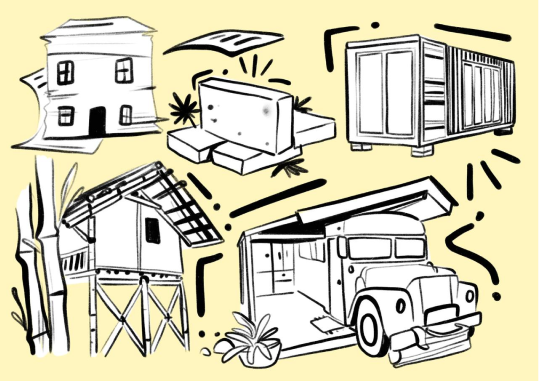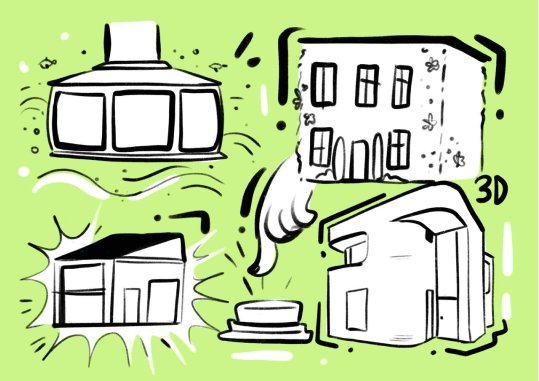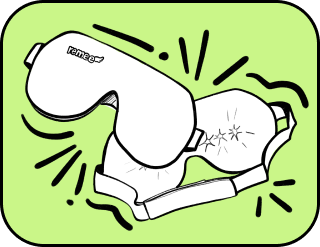How to build a house properly
“Snap, crackle, and duct tape it securely.”
An unidentified penguin from Madagascar
Morning. Bright rays of sunshine filter through the windows of a beautiful house. A dog frolics on the lawn, while apples and vibrant flowers grow in the garden. How often do you wake up wishing that house was yours? Even without the apples, it would be a dream.
Of course, there are other options—tent, hut, yurt, or dugout. But who would willingly share their living space with insects or be at the mercy of nature?
It’s time to use all the technological tricks and life hacks to turn the dream of owning your own square meters into reality. Let’s uncover the secrets, catch luck by the tail, and create a cozy little corner of our own. And if all else fails, then we’ll just “snap, crackle, and duct tape it securely.”
Why not build your very own house out of paper? Our cities are gradually being overrun by piles of trash, industrial waste, and unnecessary packaging. Plastic, polyethylene, and other chemical atrocities sit in landfills for decades without decomposing. But these are precisely the materials that interest us. Why not wake the thrifty steward within, someone who cares deeply for the environment? Carefully sort the trash, arrange for the removal of cardboard and paper, and start experimenting:
- Take a bit of single-layer corrugated cardboard and cut out numerous rectangles. These pieces will become the “bricks” for your construction project.
- Connect them with narrow bridges, and after the glue dries, you’ll have a sturdy “brick” that can even bear a person’s weight.
This free, eco-friendly material can be used for insulation or to build garden furniture. Just don’t forget to protect it from moisture. Professional builders in Germany already use similar technology—recycled paper is turned into lightweight, durable structures that are easy to assemble and don’t require a foundation.
Think recycled paper houses are the limit? In Magdeburg, they’re making tools and machine parts from a mix of paper pulp and synthetic resins. So, if you’ve got a stash of paper waste, make smart use of your “valuable trash”! This is no longer just an idea; it’s a promising reality.
Bamboo Always Wins
Bamboo homes also “breathe” exceptionally well, as if they’ve mastered the art of respiratory gymnastics. Thanks to its porous structure, bamboo regulates humidity perfectly, creating an ideal indoor climate. This makes it an excellent choice for saving on air conditioning.
Bamboo requires no investments, no special chemicals to grow—it thrives on rainwater, sunlight, and skilled hands. Building a bamboo LEGO set is so simple that even a child could do it. And who knows, perhaps Bambi himself will show up at your doorstep to admire the architectural brilliance.
Life on Wheels
A bedroom, a bathroom with a shower, a kitchen, and a bright living room with a dining area—all of this can fit in an old bus, now your new home.
If, for some reason, you don’t like buses, there are other options—like a guest house in a shipping container. A standard container offers about 30 square meters of space, which is more than enough for a modest lifestyle. However, container structures can be combined to add more rooms and even additional floors. Some skilled builders create two-story mansions out of four shipping containers, achieving spacious and comfortable homes for a relatively low cost.
The key is to choose a location with a pleasant climate so you can fully enjoy life in this unconventional home.
A Hemp House Without Pesticides
Whoa, whoa, whoa! Let’s not drool and start imagining yourself happily munching on your own house.
Hemp, by its nature, brings up some unusual associations. But who would’ve thought you could build houses from bricks made of hemp? The idea dates back centuries. Historical records suggest that the Romans used fast-growing hemp to construct bridges and buildings. So why not us?
Hemp fibers mixed with lime create a lightweight, eco-friendly concrete alternative known as hempcrete. This material retains heat wonderfully and offers incredible insulation properties. In a hemp house, you won’t encounter pests or mold, and the acoustics will be outstanding. Low humidity and the absence of pesticides are additional bonuses.
However, you won’t get any intoxicating effects from such a house because it’s built using industrial hemp. This type of hemp can grow up to 4.5 meters tall and has stems nearly 2 cm thick.
Industrial hemp grows quickly and economically. It yields two harvests a year, requires minimal fertilizers, and its long roots improve soil quality.
Manufacturers of this unique building material claim that “hemp bricks” are ideal for low-rise construction and boast a low carbon footprint. Heating a hemp house requires three times less energy than a standard concrete building. For instance, heating a 100-square-meter space with 40 cm-thick walls during winter would only consume around 3 kWh of electricity.
Why not consider such an economical and evergreen future?
A Microhome Between Skyscrapers
Let’s talk about a unique project that has already captured the world’s attention — OPod Tube. This creative idea was born in the Hong Kong studio James Law Cybertecture. Adventurers and minimalism enthusiasts are sure to love it.
Microhomes are built in the form of concrete tubes, designed to fit into any gap between towering skyscrapers. These tiny, cozy dwellings, with an area of just 9.29 square meters, bring a fresh perspective to urban living. Inside, you’ll find everything you need—a compact kitchen, a sleeping area, and a cozy corner for relaxation. The doors to these microhomes open via a smartphone, though this functionality is hardly surprising these days.
It must feel amazing to wake up in the middle of an urban jungle, where your only neighbors are skyscrapers and the chirping of birds. True, you won’t have much room to run or jump inside this micro capsule, but beyond its door, the world is wide open.
Originality, Speed, and Modularity
Modular homes are built significantly faster than traditional ones—sometimes within just a few weeks. Thanks to efficient technologies and reduced labor costs, these structures are often cheaper than their conventional counterparts.
Before construction begins, you can choose the layout, finishes, and additional modules if needed. Many modular homes can be easily disassembled and relocated. You can also experiment with the shapes and colors of the modules, giving the entire structure a futuristic flair.
Any building can be easily “upgraded” with modular extensions, simultaneously addressing the issue of affordable housing. Imagine achieving both low-cost apartments and improved building quality at the same time! No extra expenses—only benefits.
And if practical life solutions don’t suit your style, it might just be time to move on to technical ones.

Underwater Home UNreality
Science never stands still, and soon we may see underwater homes nestled among vibrant coral reefs, swimming fish, and graceful jellyfish, right next to SpongeBob’s pineapple. These homes will be crafted from durable materials and equipped with self-regenerating systems. If one of these homes gets a “scratch” from a meddling crab or a shimmering goldfish, it will repair itself in seconds. True, the price tag will be steep, but the chance to live in Bikini Bottom with panoramic views of the Krusty Krab is worth it.
Built-in smart systems will clean, cook, and entertain you. Rumor has it that even Wi-Fi essential for life will be available at a depth of 30 meters. What else could you need for comfortable ocean living?
It might be time to stock up on ocean-themed magazines and start gathering ideas for the perfect underwater interior—especially now, while currency rates remain unpredictable.
Bright Ideas Become Reality
Imagine your home as a nighttime theater, where walls emit a soft neon glow. You didn’t end up with such a house because you spent your life on Broadway, but because these homes help save energy.
Creating energy-efficient homes is simple. All it takes is cement, plaster, or any other binding material mixed with a luminescent powder. This powder is what gives your cement its magical glow.
This glowing material can be used in bathrooms, around pools, on building facades, in parking lots, and even in kitchens. The best part? You can make luminous cement yourself.
It’s no wonder this simple technological solution, known as luminescent concrete, has become a sensation in the market. Saving on electricity is a solid investment in maintaining your home.
Printed Homes
While some are building houses the traditional way, others dream of living underwater, and some are busy buying up tiny microhomes. Meanwhile, a new era in architecture—the era of 3D printing—is already taking over the real estate market and winning the hearts of developers worldwide.
First, a designer creates a virtual model, which is then converted into a code understood by a 3D printer. The printer begins “bringing the project to life,” carefully layering specialized mixes, usually concrete, to create unique shapes and structures—from intricate curves to eco-friendly designs.
Why wait months when you can have a house in just days? Some models can be printed in as little as 24 hours. 3D printing reduces material and labor costs, making building structures more sustainable—even if your dream is a house with wavy walls.
In Mexico, a project has already been implemented to provide 3D-printed homes for low-income families. Meanwhile, Dubai is home to a five-story office building created with a 3D printer.
The Dutch firm Dus Architects introduced the world to a tiny 8-square-meter 3D-printed house, available for rent in one of Amsterdam’s industrial areas.
WASP, in collaboration with Mario Cucinella Architects, created the futuristic Tecla home, with a 60-square-meter area, printed in just 200 hours.
Logan Architecture Icon printed a series of six homes for people in need, each 38 square meters. Engineers used the state-of-the-art Vulcan II 3D printer and a special concrete mix. Each home includes a kitchen, living room, bedroom, and bathroom. This 3D-printed oasis is located in a neighborhood where homeless people once lived, but now over 200 residents have found a permanent place to call home.
Building with the Press of a Button
How can we ignore a groundbreaking technology that’s revolutionizing housing construction like the creak of a wooden floor beneath our feet?
The self-building system is here—homes that build themselves.
How does it work? It’s simple! This unique home of the future starts as a compact box. Press the magic button, and the real construction magic begins—walls rise, ceilings expand, and the square footage increases eight to ten times in size. No hassle, no delays.
This innovative house fits perfectly into modern life. There’s no need to calculate budgets, argue with contractors, or guard bricks and cement at night. Just press the button, and voilà—the house is ready.
A House Grown from Seeds
The idea of growing your own house from seeds dates back to ancient legends. “Once, a poor farmer saved a stork, and in return, it gifted him a handful of watermelon seeds. When the seeds sprouted, they grew into a massive house.”
British architectural genius Maria Vergopoulou has unveiled an astonishing project of microhomes called Cocoon BioFlos. Here’s their secret: these homes are crafted from ultra-thin bioplastic fibers, derived from sunflowers, potatoes, and apples. Each home adapts to your needs, and its design seamlessly adjusts to any climate. And in a tough year, well… you get the idea.
In today’s world, finding affordable housing feels like a game of hide and seek. Some manage to discover their dream home, while others wander through a maze of high prices and endless waiting. On one hand, new technologies and innovative construction methods open doors for many. On the other, growing demand and economic realities create significant obstacles to achieving the dream of owning a home.
As a result, housing is no longer just a roof over one’s head—it has become a true status symbol, where comfort and coziness compete with financial challenges.
Let’s try to stay optimistic. Maybe in the future, accessible housing will become a reality, where everyone can find their corner of happiness. For now, let’s not forget: home is where the heart is.
And if all else fails, we’ll patch it up with duct tape, spit, and a little determination.

While living organisms undergo translocation, deletion, and duplication, we offer scientific knowledge without mutations – only useful discoveries and theories.
Thank you!




